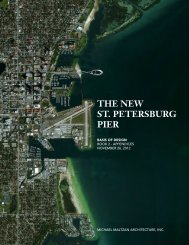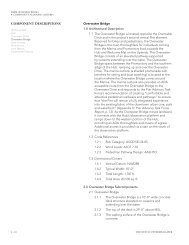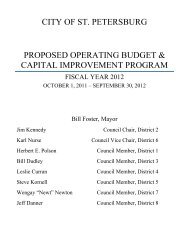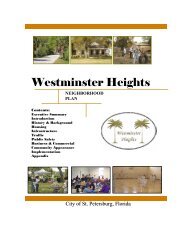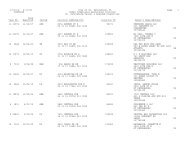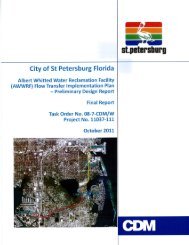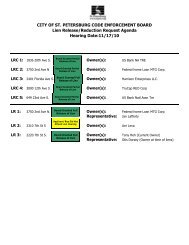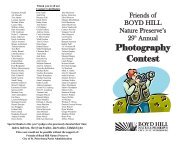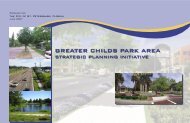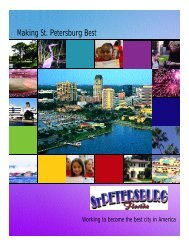Book 1 - City of St. Petersburg
Book 1 - City of St. Petersburg
Book 1 - City of St. Petersburg
Create successful ePaper yourself
Turn your PDF publications into a flip-book with our unique Google optimized e-Paper software.
Forces due to wind, waves and storm surge will directly impact<br />
the proposed Pier as it is located within the near-shore and surf<br />
zone areas. Longshore and cross-shore sediment transports<br />
are natural processes that occur at the project location. During<br />
storm events, cross-shore sediment transport rates are dominant,<br />
resulting in erosion as sand is deposited to <strong>of</strong>fshore sandbars.<br />
The effects <strong>of</strong> this on the Pier takes the form <strong>of</strong> scouring around<br />
the piles, with piles within the surf and swash zones being the<br />
most affected.<br />
The Federal Emergency Management Administration (FEMA)<br />
P-55, Coastal Construction Manual, gives guidance on the<br />
construction <strong>of</strong> residences in coastal areas. Though information<br />
pertaining directly to the design requirements <strong>of</strong> fishing piers<br />
is not provided, the content <strong>of</strong> the Manual focusing on pile<br />
foundation design and the effects <strong>of</strong> erosion and debris impact<br />
during storm events may be used in the design <strong>of</strong> the pile<br />
substructure. In general, the methods used to determine base<br />
flood elevations, wave heights and wave crest elevation, wave<br />
run-up, localized storm erosion and impact loads can be used<br />
to determine conservative values for schematic design. These<br />
are found in Chapter 3 “Identifying Hazards” and Chapter 8<br />
“Determining Site-Specific Loads”. Determination <strong>of</strong> site-specific<br />
wave loads will be determined during the next stage <strong>of</strong> project<br />
development.<br />
<strong>St</strong>ructural Criteria<br />
<strong>St</strong>ructural engineering codes governing the project include:<br />
• Florida Building Code (2010) – Chapter 16 – <strong>St</strong>ructural<br />
Design<br />
• FDOT <strong>St</strong>andard Specifications for Road and Bridge<br />
Construction<br />
• <strong>City</strong> <strong>of</strong> <strong>St</strong>. <strong>Petersburg</strong> Engineering Design <strong>St</strong>andards<br />
• <strong>City</strong> <strong>of</strong> <strong>St</strong>. <strong>Petersburg</strong> Codes and Ordinances<br />
• AASHTO LRFD Bridge Design Specifications, 6th Edition<br />
(2012)<br />
• AASHTO LRFD Guide Specifications for Design Of<br />
Pedestrian Bridges, 2nd Edition (2009)<br />
• FAA Height Restrictions for Albert Whitted Municipal<br />
Airport<br />
• OSHA Regulations<br />
• AISC – Design <strong>of</strong> <strong>St</strong>eel <strong>St</strong>ructures<br />
• ACI – Design <strong>of</strong> Concrete <strong>St</strong>ructures<br />
• Precast Concrete Institute Bridge Design Manual<br />
MICHAEL MALTZAN ARCHITECTURE, INC. 3 - 89




